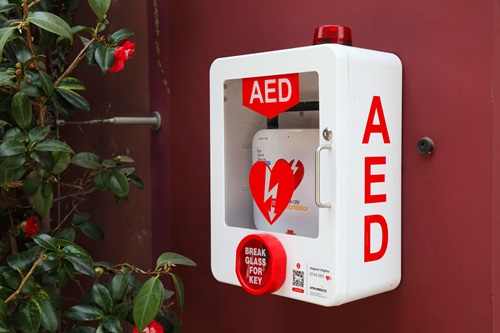
As if pickleball didn’t already have enough bounces going its way, consider this: The sport might be one major reason why new automated external defibrillators are popping up in public parks.
After 56-year-old pickleball player Sam Hopkins suffered a heart attack and died on a court last summer at Halpatiokee Park in Martin County, Fla., fellow players petitioned local parks officials to install AEDs at county facilities. In August, 34 units were put into service at 21 parks. They are stored in locked and clearly labeled waterproof yellow boxes. To access the AEDs, someone must call 911, and the dispatcher will provide a code to unlock a box.
“For every one minute that CPR is not initiated with an AED, the person’s chance of survival decreases by 10 percent,” Rodney Robertson, deputy fire chief for Martin County Fire Rescue, told WPTV.com.
“I think all of us here at Halpatiokee Park are so relieved,” said Candace Cooney, who was at the park when Hopkins collapsed. “Because for us, now that the AEDs are here permanently installed 24/7, it is a sense of security and safety that is something we’ve been waiting for [for] a while.”
After months of sorting out logistics, the Martin County Board of Commissioners approved about $150,000 for the AEDs, according to CBS12.com.
“You have to make sure when you put them out there in a public setting that they’re not going to be vandalized, that they’re going to be in a secure place,” Robertson said at the time funding was allocated. “We don’t have the ability in the first part of this [funding] to put them at all the parks, but we’re going to put them at the ones that have the most attendance of patrons.”
 Meanwhile, Fredericksburg, Virginia became one of the first communities in that state to add AEDs in local parks after a scare at one park’s pickleball courts. The AED units are in four parks and operate the same way they do in Martin County, with someone needing to call 911 before receiving access to the locked AED. Each unit cost about $2,000, according to NBCWashington.com, and they were paid for via local partnerships. The Mary Washington Hospital Foundation funded two of them, and the fraternal organization Knights of Pythias reportedly contributed $10,000 for more park AEDs.
Meanwhile, Fredericksburg, Virginia became one of the first communities in that state to add AEDs in local parks after a scare at one park’s pickleball courts. The AED units are in four parks and operate the same way they do in Martin County, with someone needing to call 911 before receiving access to the locked AED. Each unit cost about $2,000, according to NBCWashington.com, and they were paid for via local partnerships. The Mary Washington Hospital Foundation funded two of them, and the fraternal organization Knights of Pythias reportedly contributed $10,000 for more park AEDs.
The units installed at several parks and sports fields in Beverly, Massachusetts, meanwhile, operate slightly differently from those in Martin County and Fredericksburg, according to AthleticBusiness.com. The power is hardwired, and when a user opens the case, lights flash and alarms sound to alert others. Each unit also includes instructions for use.
“These days, the units are so sophisticated you don’t really need training to use them,” said Bruce Doig, Beverly’s director of parks and recreation. “That said, any training we can do will help alleviate fears of somebody trying to use the units. If someone is afraid to use the units, and then it doesn’t get done in a timely manner or in a proper manner, obviously that’s not good. But the units tell you exactly what to do and how to do it and when to do it.”
Doig also offered advice for municipal officials considering the installation of AEDs in parks. “A proper maintenance plan should be in place,” AthleticBusiness.com reports. “The units Beverly has purchased have a battery warranty of five to seven years but given that the units are permanently installed in public places, they should be regularly inspected for tampering or inoperability. The pads also have to be swapped out occasionally, as they can expire and lose their stickiness. Beverly will also be installing signage to ensure that park and field patrons know exactly where the AEDs are located, should trouble arise.”
Plans to create a safety and inspection strategy to maintain the health of Beverly’s AEDs are in the works, too.
“[This is] the right thing to do,” Doig said. “Obviously, we’re hoping we never have to use [an AED]. But not having them there will be much more troubling if something does happen, and we’re not ready for it.”

